This is one of a series of blogs about the changing B2B Go-To-Market landscape. You can check out the others in the series at the bottom of this piece.
We felt something changing last year: What had worked in B2B marketing seemingly wasn’t anymore.
A dip in campaign performance. Tightening budgets. Falling engagement and lagging pipelines drove clients to focus intensely on lead gen and sales activation, while the appetite for long-term brand building collided with revenue urgency.
We saw instances become a pattern, and a pattern become a trend. Before long, the writing was on the wall: The inbound era — and the golden age of content marketing — was in a tailspin.
It wasn’t a total shock (it felt somewhat inevitable the moment we hit publish on Crap ten years ago), but it left a big, scary question hanging in the air: what the hell comes next?
Towards the end of 2023, we set out to answer that question with a campaign that built the answer in public — and then market the shit out of it.
It’s been pretty successful so far. And in the spirit of eating our own dog food/spilling our guts/sharing our secret sauce (dios mio, marketing analogies are foul), this is the first of a three-part series explaining our whole process.
Here’s what we’ll cover:
Part one: The story, audience, strategy, campaign plan / goals and KPIs
Part two: The execution, the reporting and early results
Part three: The future
The story
The core of the new story is this: The old B2B GTM playbook that rose to prominence during the inbound era is dead.
The truth is the early promises of inbound — of valuable content experiences that earned the right to sell — never really survived contact with the market. Quarter by quarter, the business lost its appetite for slow-burn brand building, and (unconsciously) conflated success with lead volumes above all else.
Over time, marketers unintentionally taught buyers that the price of (underwhelming) content was perpetual bombardment by outbound sales artillery — and to little surprise, buyers disengaged.
We weren’t the first to arrive at this diagnosis — serial Velocity client Jon Miller had been writing about this dynamic earlier in the year. And a killer insight from the Ehrenberg-Bass Institute cemented the narrative: Only 5% of B2B buyers are in-market at any one time.
The answer to “what comes next?” felt like a new GTM playbook that connects creative brand building to mature performance marketing — to build a relationship with 95% of future buyers and sell more intentionally to folks actually ready to buy.
That’s the view from 1,000 feet. If you want the nuance, our blog series on the evolution of B2B marketing is a good place to start.
Next up: Tightening up our audience.
The audience
Part of the new GTM playbook is dialling up the specificity of who you sell to, and how and when you sell to them.
Velocity has always sold to “B2B tech companies.” But there’s a more nuanced sweet spot of companies within that group that share specific demographic and psychographic traits.
But after a shit load of thinking and research, we built a Target Account List (TAL) of companies that fit this description: Ambitious, mid-sized B2B tech companies who have a pipeline problem and need to move fast but lack the team and resources to deliver strategy and performance.
There’s a lot more detail there — we’ll save it for the next post.
So, we knew what we wanted to say, and who we wanted to say it to. But WTF did we actually want to achieve?
Our campaign plan
One of the best ways that companies can cement their authority in changing industries is to help the market move towards the new world (rather than catch up to where it’s heading).
One move we often recommend is that clients become the best educators of their market — to help prospects before selling to them, by giving away as much information and best practice as possible.
(We wrote about this a while ago: read If your content doesn’t cost you anything, it isn’t worth anything).
With that in mind, we pulled together this campaign skeleton:
A blog series
Ten posts (and counting) telling the story of ‘The Evolution of B2B Marketing’.
- Stop the relay race: The evolution of B2B marketing and why yours isn’t working
- The universal digital marketing audit
- Performance branding: Why strategy and data must work together to drive pipeline
- Why teamwork solves the B2B SEO malaise
- Symptoms of B2B selling sickness
- The new B2B GTM playbook: An interview with Jon Miller, one of the architects of the old one
- Recombinant innovation: Why B2B marketing collaboration is worth the effort
- What Gong’s Chief Evangelist thinks the new B2B marketing playbook should look like
- Content as community
- How integrating B2B SEM and SEO helps you win through volatility
Two marquee assets
- Brand is back (and MQLs are bullshit): A new sort-of B2B Marketing Manifesto
A short, beautifully designed digital piece that passionately voices our feelings - The Big, Beautiful B2B Blueprint
A practical, step-by-step workbook to guide B2B marketers towards a new GTM that unifies brand and performance to slam dunk even the most ambitious KPIs
A promotional campaign
A slew of ads and posts on LinkedIn that brought more folks to our campaign by providing value in their own right.
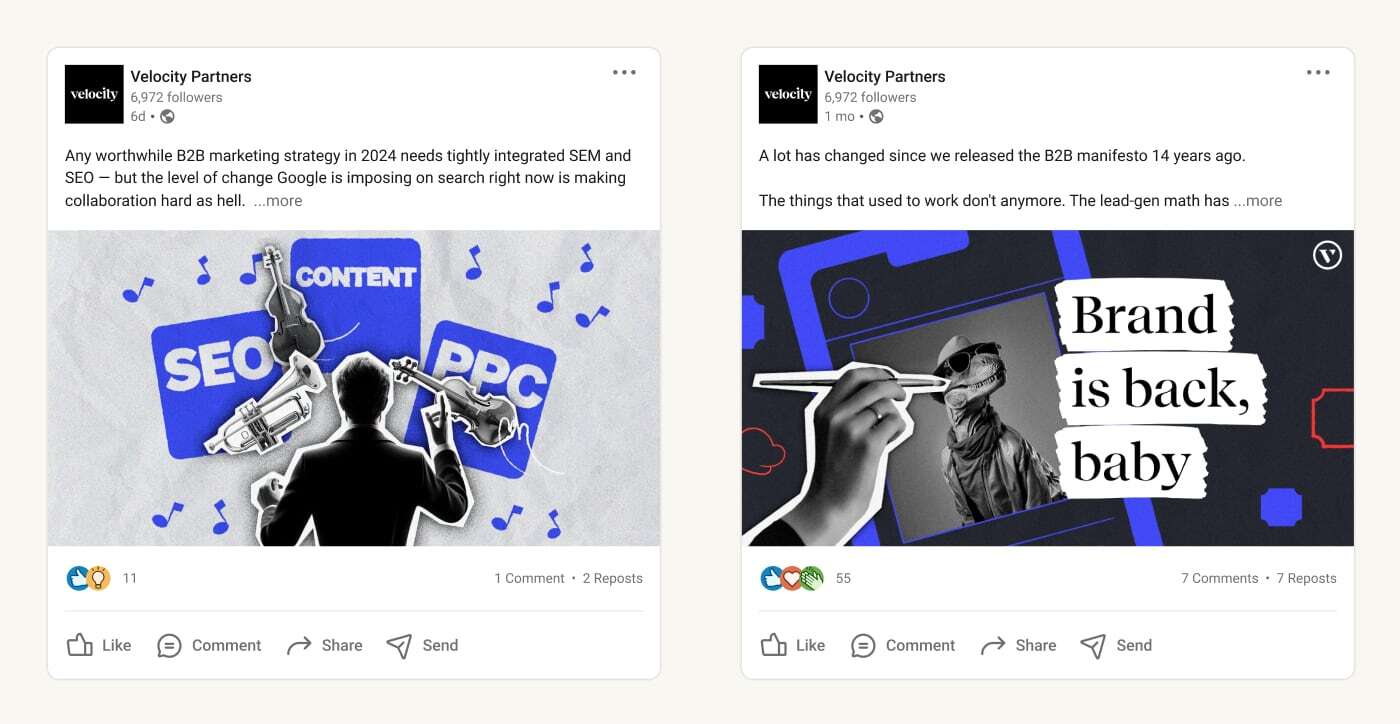
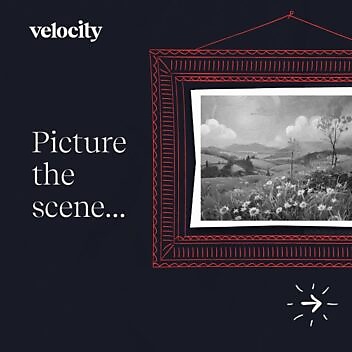
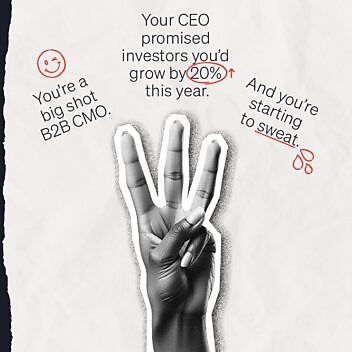
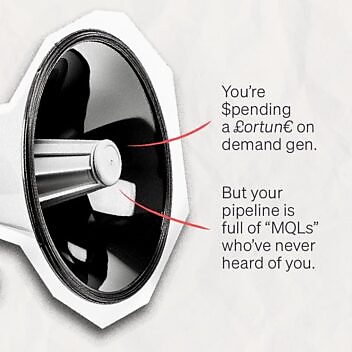
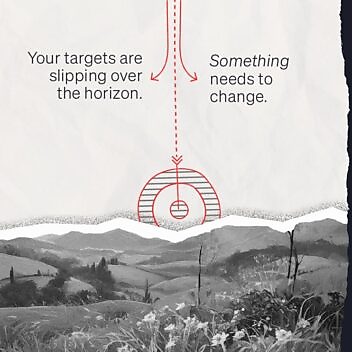

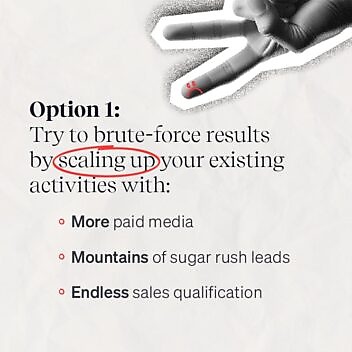
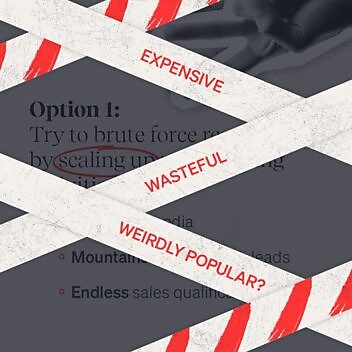
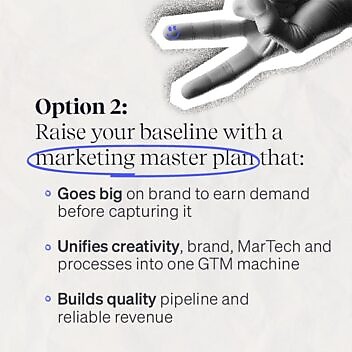
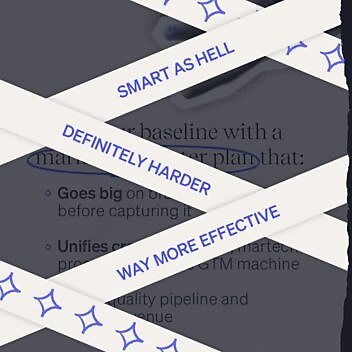
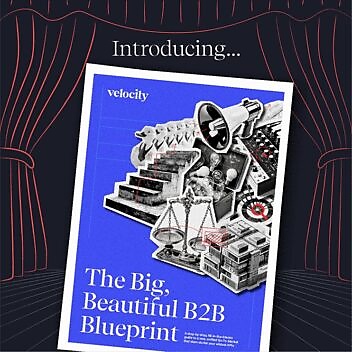
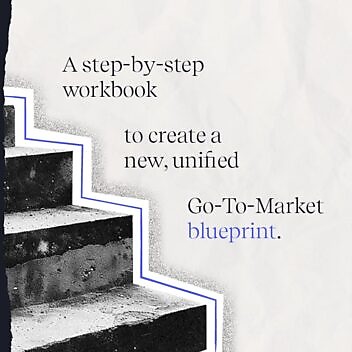
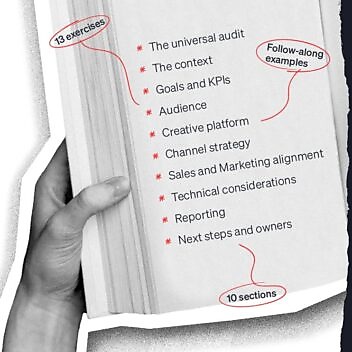

We wanted to get started quickly, so rather than front load the production, we outlined the themes that sprang from our initial story — and the topics we’d need to cover in order to provide the most value for the TAL list we’d assembled — and created assets as we ran.
The final piece of the puzzle was to get really specific about the goals we wanted to hit, and the KPIs that would indicate success.
Our goals and KPIs
We had a mixture of long-term strategic aims and one big hairy-ass commercial goal:
- Grow our organic presence
Just like the B2B offers we help clients sell, we know the buying cycle for B2B marketing services takes time. The key is to get famous enough around the topics your best customers care deeply about, that your name is front of mind the next time the marketing budget is being planned. So we set about to associate Velocity’s name with the new evolution of B2B marketing — by helping prospects improve their marketing today, and building enough memory links (to borrow a term Udi Ledegor uses at Gong) that they might become clients down the line. - Drive newsletter sign-ups
Like we covered in Content as community, paid channels like LinkedIn are steadily strangling organic reach. They’re necessary to reach your audience, but you shouldn’t build your house on rented land. We’re trying to build a brand that our audience wants to spend time with — and the Velocity newsletter is one of the best tools in our arsenal to build a regular relationship with the marketers we serve. - Generate $1 million in pipeline from a promotional budget of $10,000
This is the big one. A hairy, scary target that puts our money where our mouth is, and proves to our market that the stuff we sell moves the needle on revenue. It’s still relatively early in the campaign, but we’ve had really promising results so far — and we’re going to get into that in more detail in the next post.
SO. That’s the 1,000-foot view of the set-up for our ‘Evolution of B2B Marketing’ campaign. It’s been a wild, bumpy joyride. We’re proud as hell of how things are going so far, and we’re looking forward to sharing more gory details and early results with you next time.
We love talking about this stuff — if any of this made your brain go brrrr, or you have questions, objections or a THIRST for more marketing nuggets — get in touch or follow us on LinkedIn for more shenanigans.
See you at the next one.

Founder
Stan started out in university teaching before moving into military intelligence. By a circuitous route, he found himself heading up the UK’s biggest tech PR company (Brodeur) and flogging it to Omnicom.
Published in:
b2b-marketing
b2b-seo
digital-marketing

Enjoyed this article?
Take part in the discussion




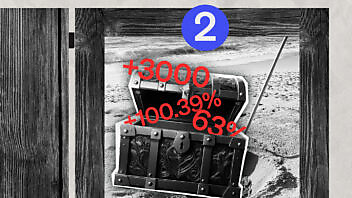










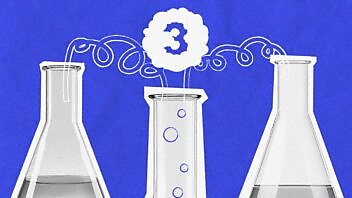




Comments
There are no comments yet for this post. Why not be the first?